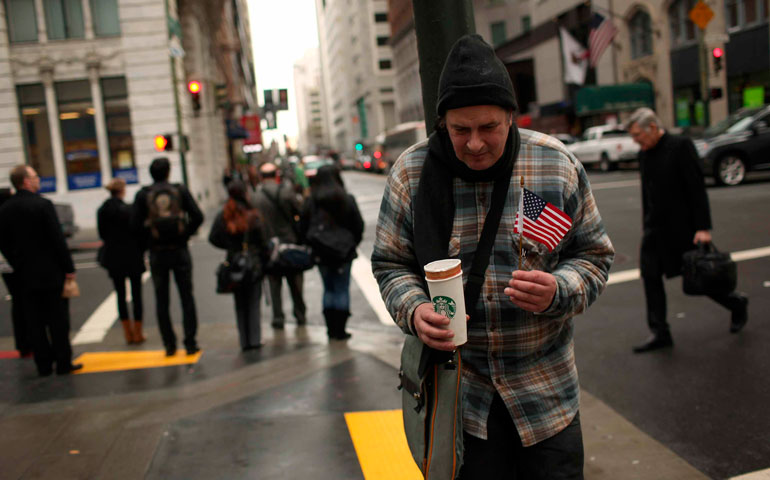
A man who is panhandling holds an American flag in the financial district in San Francisco March 28, 2012. (CNS/Reuters/Robert Galbraith)
 THE BETRAYAL OF THE AMERICAN DREAM
THE BETRAYAL OF THE AMERICAN DREAM
By Donald L. Barlett and James B. Steele
Published by PublicAffairs, $26.99
“I placed my bet on the American worker. And I will make that bet any day of the week” was a mantra of President Barack Obama’s re-election campaign.
The problem is not the American worker. In The Betrayal of the American Dream, Donald L. Barlett and James B. Steele tell a story of how policies that were developed over decades create vast inequality and betray the middle class -- whom they view as the “heart and soul” of American democracy.
If the “American dream” is the unabated freedom of capitalists to exploit workers and markets for the highest attainable profit, then it is alive and well. The problem is not only that the U.S. has become a plutocracy, a nation governed by and for the wealthy, but that we have become a “plutonomy,” a term coined by strategists at Citigroup to describe a singular mark of the U.S. economic system: unparalleled income and wealth inequality.
Vanity Fair investigative reporters Barlett and Steele explain that when the term plutonomy was coined in 2005, the top 1 percent of U.S. households controlled more than $16 trillion in wealth -- a sum greater than all the wealth held by the bottom 90 percent. The average earnings of the top 1 percent in 2010 were $950,000 while the average earnings of the bottom 90 percent were $36,000.
If the Occupy movement taught us facts of massive inequality, the authors teach us how 30 years of public policies got us there: Had the yearly earnings of manufacturing workers from 1990 to 2010 gone up at the same rate as that of CEOs, factory workers would earn on average $82,000. In fact, factory workers now take home about $40,000 per year. Equally startling, by contrast, CEO pay was 100 times that of factory workers in 1990. Today it’s 325 times that of factory workers.
In the U.S. plutonomy, capitalists have thrived, even through the Great Recession, while millions in the middle and at the bottom lost their homes, jobs, health care and retirement savings that they will never recover.
The book illuminates public policy history through its compelling human stories of workers and families whosuffered the brunt of corporate greed and political indifference.
What I find disconcerting, even frustrating, with Barlett and Steele is how they never question national cultural assumptions of the American dream. How have we, as a national electorate, been duped for so long? The authors don’t ask. They do tell us how the betting table has been skewed against the working poor and middle class, and that even if the president and Congress were willing partners, it would take several terms, perhaps decades, to re-establish a modicum of fairness.
Our political system is designed to force compromise or failure. While it is true that both parties are complicit, our current political malaise is largely driven by the desire of one party to risk the well-being of the nation, perhaps even the world, to defeat Obama at every turn. Barlett and Steele don’t address this reality or how it is interwoven with a deeply racist culture.
The dream itself is our problem. We valorize those who have attained exorbitant affluence. We want it. We buy and sell the dream every day with no mind for how it is killing our families, communities and democracy itself.
Perhaps not so ironically, 47 percent of the nation voted for Mitt Romney. He never stood for any traditional conservative values for family, community or even the right to life. The fundamental tenet of Romney’s candidacy and of plutocrats is that the nation ought to be run as a business. In doing so, as a nation we commit ourselves to the capitalist axiom that everyone is expendable. To their credit, Barlett and Steele recognize how we have all become expendable.
When we buy into the dream, we have lived by the assumption that “my job is safe” or the “dream” is within my grasp. We tend to resign ourselves to the expendability of other workers. When President Ronald Reagan broke the Professional Air Traffic Controllers Union in 1981, too few were concerned enough for the fate of all American workers.
Since Reagan, the concentration of wealth and power in the hands of the few has not happened without a willing electorate and culture. One of the perversities of buying into the American capitalist dream is that we have joined the battle for capitalism and plutocracy and against the most vulnerable among us.
As a society, we don’t really recognize how our common fate is bound up with the most vulnerable. We don’t live, act or vote as if our lives depended on the fate of the poor, people of color, those who are disabled, or returning veterans.
Barlett and Steele’s final chapter, “Restoring the American Dream,” a cogent list of policy recommendations -- revise the tax code, make trade fair and invest in America -- sounds wildly romantic given the current political impasse in Washington.
The Betrayal of the American Dream ends with the wisdom of Supreme Court Justice Louis Brandeis: “We can have concentrated wealth in the hands of a few or we can have democracy. But we cannot have both.”
Sadly, as a nation, we have been placing our bets on the capitalists and plutocrats. To them, the right to life and liberty for the rest of us is completely expendable. Until we can look critically at our own love of capitalism, we’ll fail to see, much less enact, an alternative moral economy, one truly human and practically possible.
[Alex Mikulich is co-author of the just released The Scandal of White Complicity in U.S. Hyper-incarceration: A Nonviolent Spirituality of White Resistance (Palgrave MacMillan).]




